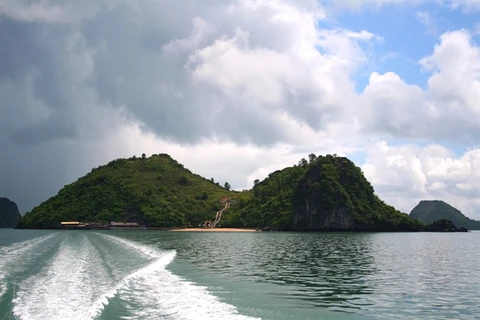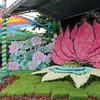Over the next five years the night-time economy will be a focus of the city’s development goals and is expected to thrive.
Vice Chairman of the municipal People’s Committee Nguyen Ngoc Son said that over the past five years, 6-10 million travellers have visited Ha Long each year. It welcomed 11.9 million holidaymakers last year, 30-35 percent of whom were foreigners, mainly from Europe.
Local authorities plan to develop dance clubs, karaoke lounges, cinemas, exhibition spaces, arts performances, and casinos at night, as well as promote sightseeing tours around the city.
Shopping centres, convenience stores, and restaurants will be open later at night to serve customers.
One of the new points in the development of the city’s night-time economy is a proposal to open 12 pedestrian streets and 12 squares to attract visitors.
Besides waterfront streets along Ha Long Bay, there would be other routes reserved for pedestrians at Sunworld, the Tuan Chau tourism site, and the Dong Che flower village.
Prime Minister Nguyen Xuan Phuc has approved a project to develop the night-time economy in Vietnam to allow some activities to run overnight until 6am of the next day in some major tourism cities and zones.
The project aims to exploit the potential of the night-time economy in Vietnam to promote overall economic growth, improving incomes for residents while limiting risks and negative impacts on political security, social order and safety.
Under the project, night-time activities would have expanded opening hours in some key tourism areas, including Hanoi, Quang Ninh, Hai Phong, HCM City, Da Nang, Hoi An, Thua Thien-Hue, Can Tho, Da Lat and Phu Quoc.
After the pilot implementation, evaluation of the economic efficiency and management efficiency would be carried out to develop an operating model for the night-time economy and bring it to other localities.
Specific night-time activities allowed under the plan were not disclosed.
Under the project, policies to encourage enterprises and business households to participate in the night-time economy would be developed, including improving their capacity to access official financial sources, especially banking credit.
Tourism promotion for night-time activities would be enhanced together with building night-time tourism products based on the cultural factors of each locality.
The PM also asked provincial and municipal People’s Committees to study night-time economic models appropriate for their areas.
Both the negative and positive impacts of night-time activities must be carefully studied, he said, requesting localities to develop plans for areas to implement night-time activities in the future.
According to Tran Dinh Thien, former Director of the Central Institute for Economic Management, it was necessary to carefully study the model for the night-time economy in Vietnam.
Security would be a major factor when developing a night-time economy, experts said.
In an article in Cong Thuong (Industry and Trade) magazine on February 25, Luu Thanh Tam from the HCM City University said that although some tourism products which happened from 6pm to 3am of the next day were very profitable, these products were not well-developed in Vietnam.
The night-time economy was not just night markets, discos, bars, karaoke joints or pedestrian streets but should include shopping, dining and a range of other services such as transportation, trade and cross-border financial transactions, he said.
According to Tam, to develop the night-time economy, it was necessary to have specific planning. In the early stage, only large investors and high-quality services should be allowed until efficient management measures were raised.
Under current regulations, public activities are not allowed after midnight. Only clubs inside tourist accommodation establishments rated at least three stars or higher are permitted to open after midnight but not later than 2:00 am the following day./.
























